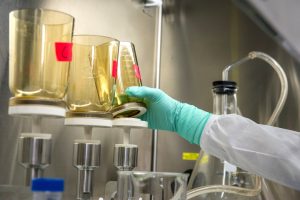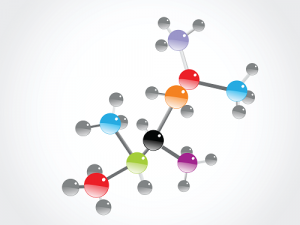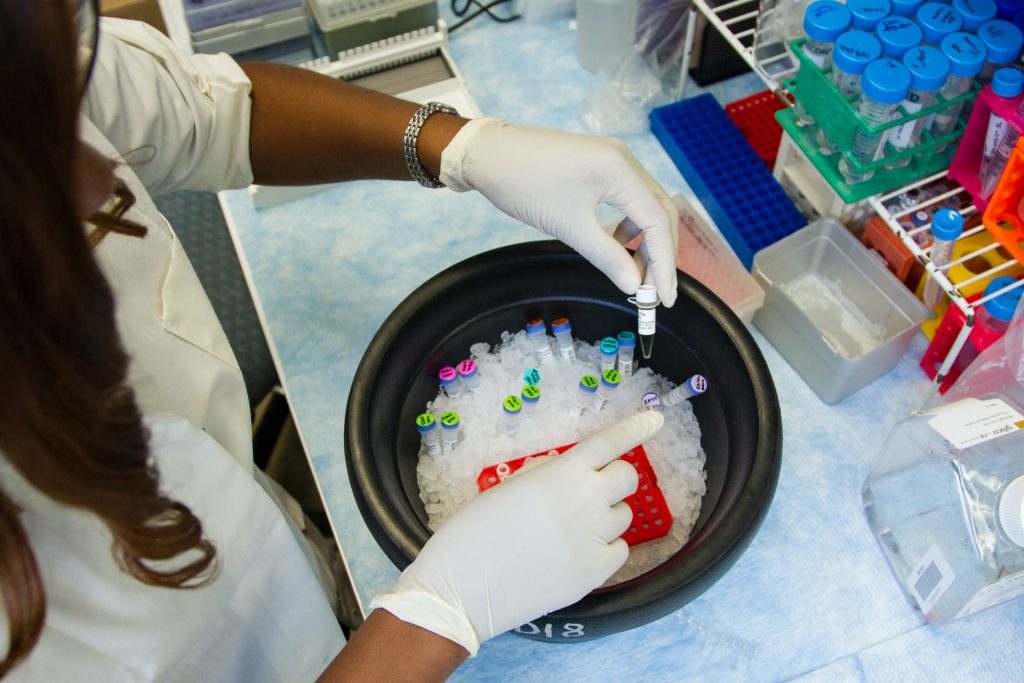By Dr Alan Rawle
Imagine that I gave you a matchbox and a ruler and asked you to tell me the size of it. If you said 20mm, you would be right – partly. A complete answer would be 20 X 10 X 5mm. This description takes into account allects of the size, whereas a single measurement does not.
The situation is even more difficult for a complex shape like a grain of sand or a pigment particle.
Ideally, if you are a quality control manager, you want a single number that describes the particles in the process flow. It needs to tell you, for example, whether the particle size has increased or decreased since the last production run.
This then is the basic problem of particle size analysis: how to describe a three-dimensional object using just one number.

The Equivalent Sphere
A sphere is the only shape that can be described by a single number. If you say that you have a 50mm sphere, this describes it exactly. It is impossible to do the same even for a cube, where 50mm may refer to an edge or a diagonal.
Returning to the matchbox, this has a number of properties that can be described by a single number – weight, volume, and surface area for example.
So, the weight of the matchbox can be converted into the weight of a sphere (using the formula: Weight = (4/3)p r3.r), enabling the calculation of one unique number (2r) for the diameter of a sphere that has the same weight as the matchbox.
This measurement of some one-dimensional property of a particle, and referring it to a sphere to derive one unique number, is known as the Equivalent Sphere theory.
This removes the need to describe three-dimensional particles with more than one number. Using Equivalent Sphere theory, it is at least possible to say that a particle has got bigger or smaller, according to changes in volume or weight properties.
Different Measurement Techniques, Different Answers

The examination of a particle under a microscope provides a two-dimensional image. There are a number of diameters that can be measured in order to characterize it.
If you take maximum particle length as the diameter, you actually say that the particle is a sphere (equivalent) of this maximum dimension.
Using minimum diameter or some other quantity such as Feret’s diameter, minimum length, volume, or surface area, will produce a different particle size result.
Each answer will be correct, giving a true result for the property being measured. It follows, therefore, that the only sensible comparison of measurements is by using the same technique.
The answers become meaningless if two different measuring procedures are used to compare values at different points in the processing chain or if different departments use different measurement methods.
This also means that there cannot be anything like a particle size standard for grains of sands. Standards must be spherical for comparison between techniques. However, it is possible to have a particle size standard for a particular technique, permitting comparisons between instruments that use that technique.
D[4,3] etc
Imagine three spheres of diameters 1,2 and 3 units. What is the average size of all three?
If you sum all the diameters (Sd=1+2+3) then divide by the number of particles (n=3), the answer is 2. This is the mean number, or more accurately the number length mean because the number of particles appears in the equation:
Mean diameter = (1+2+3)/3 = 2.00 = S d/n
In mathematical terms, this is called D[1,0] because the diameter terms on the top of the equation are to the power (d1), and there are no diameter terms (d0) on the bottom of the equation.
However, a catalyst engineer will want to compare these spheres on the basis of surface area because the higher the surface area the higher the activity of the catalyst. The surface area of a sphere is 4p r2, so to compare on the basis of surface area, the diameters must be squared, divided by the number of particles, and the square root taken to get back to mean diameter:
Sq. rt. {(12+22+32)/3} = 2.16 = Sq. rt.(Sd2/n)
This is a number-surface mean since the number of spheres appears on the bottom. The squares of the diameters are summed, so mathematically this is called the D[2,0] – diameter terms squared on the top, no diameter terms on the bottom.
A chemical engineer may want to compare spheres on the basis of weight. As the weight of a sphere is (4/3)p r3.r , then the diameters must be cubed, divided by the number of particles and a cube root taken to get back to a mean diameter.
Cube rt. {(13+23+43)/3} = 2.20 = Cube rt.(Sd3/n)
This again is a number mean (number-volume or number weight mean) which in mathematical terms is expressed as D[3,0]. This is what is usually understood as the Volume Mean Diameter (VMD).
Academics normally prefer the D[4,3] – the volume moment mean of the particle, because the number of particles is not required. This would be inconvenient for any measurable size of fine powder (1g of powder of density 2.5 would contain around 7.6 X 1011 particles if all were 1mm).
D[4,3] = (14+24+34)/(13+23+33) = 2.72 = Sd4/S d3
The surface area moment mean D[3,2] or Sauter Mean Diameter (SMD), is often of use in applications where the active surface or surface area is important (eg. catalysis or combustion).
D[3,2] = (13+23+33)/(12+22+32) = 2.57 = Sd3/S d2

Different techniques give different means
Using an electron microscope, it is likely that diameters will be measured with a graticule, then summed and divided by the number of particles to give a mean. This is the D[1,0] number-length mean.
Image analysis measures the area of each particle and divides by the number of particles to generate the D[2,0].
A technique like electrozone sensing will measure the volume of each particle and divide by the number of particles to give the D[3,0].
Laser diffraction can generate the D[4,3] or equivalent volume mean, which is identical to the weight equivalent mean if density is constant.
So each technique is liable to generate a different mean diameter as well as measuring different properties of the particles. Thus there is an infinite number of ‘right answers’.
If measurement is made using an electron microscope to give the D[1,0] number-length mean and mathematically convert to the number mass mean, what are the consequences of making this conversion?
If the electron microscope measurement is subject to an error of ±3% on the mean size, with conversion the error will increase to ±27% because the mass mean is a cubic function of the diameter and so the error will also be cubed.
Using laser diffraction to calculate the mass or volume distribution the situation is quite different. For a stable sample measured under re-circulation conditions in liquid suspension the volume mean reproducibility should be ±0.5%. Converting this figure to a number mean gives an error that is the cube root of 0.5%.
In practice, this means that using an electron microscope when what is really needed is volume or mass distribution, the effect of ignoring one 10mm particle is the same as ignoring or missing 1000 X 1mmparticles. The dangers of inter-conversion are therefore very significant.
So, which number should you use?
The simple answer is that it depends what you are measuring and why.
If you are making gold you will be interested in the weight of the material an less interested that the process stream contains 3.5milllion particles.
Remembering that the mass mean is a cubic function of diameter, it can be seen that a sphere of diameter one unit has a mass of one unit. A second sphere of diameter 10 units has a mass of 103 (1000) units. That is, the larger sphere makes up 1000/1001 parts of the total mass of the system.
If you are making gold, you can safely throw away the sphere of one unit since you will be losing less than 0.1% of the total mass of the system.
That is why D[4,3] is much more useful to chemical process engineers.
However, if you work in a clean-room environment making wafers of silicon or gallium arsenide, a single particle landing on the wafer will tend to produce a defect. Here the number or concentration of particles is very important, and you would use a technique that directly measures the number of particles or gives/ the concentration.
This is the difference between particle counting and particle sizing.
Counting enables each particle to be recorded and counted. Since size is less important, a limited number of size classes are required.
With sizing, the absolute number of particles is less relevant than the sizes or size distribution of particles and more size bands are needed.
Methods of measurement – advantages and disadvantages
There are five main methods used in process industries:
Sieves
An old fashioned, but cheap and readily usable technique for large particles, such as those found in mining and some food processing applications. It allows separation into some size bands if required.
Using this technique it is not possible to measure sprays or emulsions and dry powders under 38m m are difficult. Cohesive and agglomerated materials, such as clays, are also difficult to measure and materials like 0.3m m TiO2 are impossible.
The longer the measurement times the smaller the answer, as particles orient themselves to fall through the sieve.
A true weight distribution is not produced as the method relies on measuring the second smallest dimension of the particle. This can produce strange results with rod-like materials such paracetamol. It is a low-resolution method and usually only four to five size classes are provided.
Sedimentation
This is the traditional method in the paint and ceramics industries and uses equipment as simple as the Andreason pipette or as complex as centrifuges and X-rays.
However, as the density of the material is needed, it is no good for emulsions where the material does not settle, or for very dense material that settles too quickly.
Temperatures also require close monitoring in order to control viscosity. A 1oC change in temperature will produce a 2% change in viscosity.
Other disadvantages include slowness of measurement, which makes repeat measurements tedious. Irregularly shaped particles, such as disc-shaped kaolins, take even longer to settle due to their increased drag compared with spherical particles. The technique also has a limited range, with particular difficulties below 2m m and above 50m m.
Electrozone Sensing
This technique was originally developed for sizing blood cells. For industrial materials it has many drawbacks.
It is difficult to measure emulsions and impossible to measure sprays. Dry powders require suspension. Measurement must take place in an electrolyte, which creates difficulties for organic materials, and the method requires calibration standards that are expensive and change size in distilled water and electrolyte. It is slow for materials of relatively wide particle size and it is not easy to measure particles below 2m m. Porous particles and dense materials pose additional problems.
Microscopy
This is an excellent technique that allows direct examination of the particles in question, and one that is relatively cheap. However, it is not suitable as a quality or production control technique beyond the level of simple judgement. Also, as relatively few a particles are examined, there is a real danger of unrepresentative sampling and if weight distribution is measured results are magnified. Missing one 10m m particle has the same effect as missing one thousand 1m m particles.
The National Bureau of Standards (NBS) recommends that a minimum of 10,000 images (not particles!) must be examined for statistical validity (A L Dragoo et al “A critical assessment of requirements for ceramic powder characterization” Advances in Ceramics Vol 21 Ceramic Powder Science (1987). The American Ceramic Society Inc.).
Sample preparation for electron microscopy is laborious and slow, and for manual methods, fewer particles are examined.
Laser Diffraction
More accurately called low angle light scattering (LALLS), laser diffraction is becoming the preferred standard in many industries for characterization and quality control. It offers a wide dynamic range and is very flexible. For example, it is possible to measure the output for a spray nozzle to get the correct droplet size, which has led to its wide application in the pharmaceutical and agricultural industries.
Dry powders can be measured directly, and liquid suspensions and emulsions can be measured in a re-circulating cell. This gives high reproducibility and enables the use of dispersing agents and surfactants to determine primary particle size.
LALLS is non-destructive and non-intrusive, and a volume distribution is generated, which is equal to the weight distribution where density is constant, making it of direct relevance to chemical engineers.
Other benefits are rapidity, answers in under a minute, repeatability for reliable results, and high resolution. There is no need to calibrate against a standard, but equipment performance can be easily verified.
In Conclusion
Particle size analysis is something of a paradoxical subject. The more you begin to understand it, the more complex it can seem. Malvern Instruments has a range of monographs and articles available to help both with a basic understanding and apply particle analysis in specific areas. Our application experts offer a broad range of experience and expertise and can provide help and advice.
